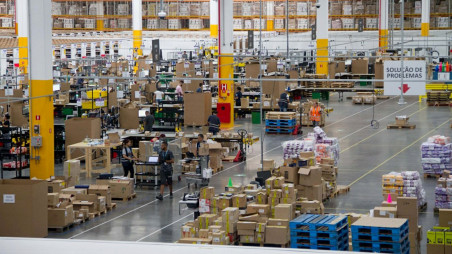Amazon’s new ‘factory towns’ will lift the working class
The growth of US e-commerce infrastructure demands that ‘factory towns’ are created and what they will need to thrive is addressed

The campaign against economic inequality has put a bullseye on cities. Local governments are encouraged to raise minimum wages, change their zoning laws and build more housing, particularly in affluent communities that are squeezing out the lower class.
But what if you shifted that focus to a different kind of community? Consider these burgeoning new places strung along the interstate and other highways leading away from urban cores, populated by warehouses and fulfillment centers that are being built to serve the needs of e-commerce customers.
Let's call them "factory towns."
These are places where working-class jobs are being created in large numbers and where wages already are rising. They are not much in the spotlight yet, but making these modern-day company towns more livable for the working class might be a better approach to solving inequality — with a higher likelihood of success — than continuing to fight against entrenched interests in coastal cities and high-cost parts of metro areas.
It used to be that when you were driving out of a metro area on a highway you would notice the change in scenery as it went from urban to rural. Today what is most noteworthy is the transition to humongous warehouses and distribution centers, both currently in use and many more being built.
Retail and e-commerce goliaths Amazon.com Inc. and Walmart Inc. have distribution facilities everywhere, and while they may have the biggest footprint, companies that make building materials have their fair share, as do other e-commerce players like pets-supplies company Chewy Inc.
Economic realities dictate where these facilities get built. The need for speedy deliveries makes it important to be close to large concentrations of customers, but because the facilities require so much land, hundreds of thousands of square feet or more, they tend to be on the outskirts of cities where land is abundant and cheap. Highway proximity is a must so that trucks can quickly get in and out.
These warehouses also provide jobs to large numbers of people; an 800,000 square foot Amazon building employs between 1,000 and 1,500 full-time workers. So when you have multiple large warehouses operated by different companies packed along boths sides of the highway in close proximity, you can be talking about a cluster employing many thousands of workers.
Now consider Amazon's announcement this week that it's making another big hiring push at its fulfillment centers with jobs paying an average starting wage of $18 an hour — up 20% since 2018. Thinking about the growth of fulfillment and distribution centers in general, maybe these highway warehouse communities with jobs that pay increasingly respectable wages are what the future of the working class looks like. And doesn't it make sense, then, to think about how we can make these communities better for the people who will live and work there?
It starts with making the jobs as high-paying and safe as possible, whether that can be done by running labor markets hot, or perhaps with unionisation or the threat of it. If these sorts of jobs get to an average wage of $20 an hour then a household with 1.5 full-time workers in it would make $60,000 a year with benefits. People can argue about what constitutes a reasonable working class lifestyle, but that would seem to offer the prospect for a much better existence than service workers had a decade ago, particularly considering lower housing costs on the outskirts of metro areas.
People can live close to work with shorter commutes — plus the possibility of employer-provided shuttle buses — when their jobs are in a cheaper, less-crowded part of a metro area. If there's a push to increase density by building affordable apartments or townhomes for workers, there's less likely to be wealthy homeowners mobilising to stop it, since those sorts of homeowners probably will live closer to the city core.
As wages rise and more jobs are created at warehouses and distribution hubs, you'll get a secondary increase in economic activity as amenities like retail and dining are built close by to appeal to the workforce.
These new factory towns will presumably have new issues that need addressing, such as adequate amounts of housing, schools and healthcare facilities. But the point is that we need to be thinking about what sorts of communities are being created by the growth of US e-commerce infrastructure, and what they'll need to thrive.
To urbanists, contemplating the potential of the area surrounding Interstate 75 in Ocala, Florida, outside of Orlando might not be as attractive as upzoning and building transit in San Francisco, but it is these types of new communities that are going to be the future of a large segment of the working class.

Conor Sen is a Bloomberg Opinion columnist and the founder of Peachtree Creek Investments.
Disclaimer: This article first appeared on Bloomberg, and is published by special syndication arrangement.



 Keep updated, follow The Business Standard's Google news channel
Keep updated, follow The Business Standard's Google news channel
















